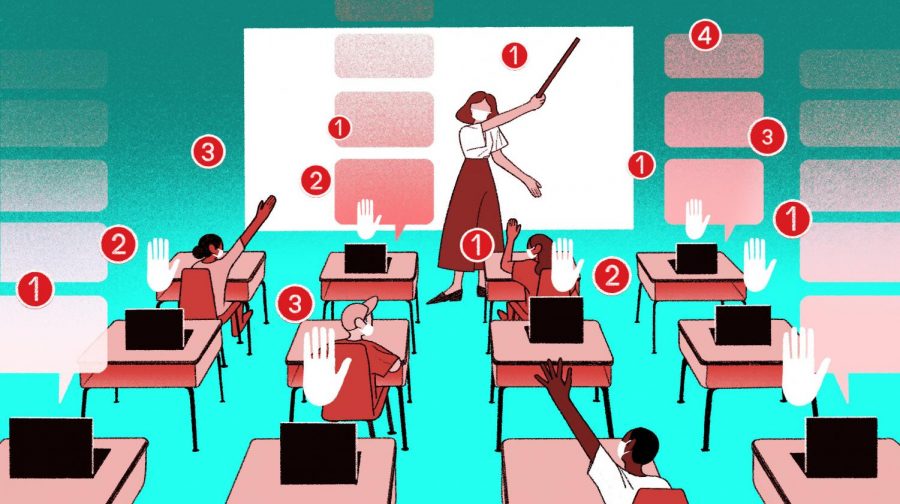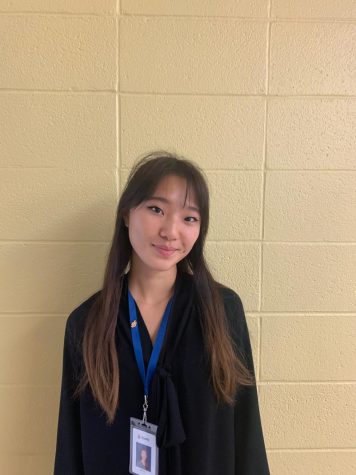Hybrid Schedule from Teachers’ Perspectives
October 29, 2020
“You might have a little trouble seeing the board,” said Mrs. Oppedisano to the virtual students on September 29th, Tenafly High School’s first day of hybrid learning. By little, I did not think she meant for us having to squint at hieroglyphics from a pixelated Chromebook camera set up 50 feet from the SmartBoard. I did not think that my classmates and I would be waving our arms in the air, repeatedly calling her name, and spending half an eternity typing in the Zoom chat, just to see her walk past the screen, oblivious to our futile attempts at grabbing her attention. I did not think that we would be left in the abyss while those in school peacefully continued their discussion of Sophocles’s Oedipus Rex. As my peers reported, it was like listening to airplane turbulence in a tornado—even monkey noises would have been more coherent than what we experienced that class period.
The switch to going all-virtual in March of 2020 was not an easy transition. From discarding entire lesson plans to cancelling final exams and state testing, last school year was a chaotic feat. Now with more preparation at hand, Tenafly High School teachers are equipped with new technology and applications to assist new classes of students. I have heard students complaining about all the mishaps during the past month of school; failed microphones, pixelated boards, and unstable network connections are just the tip of the iceberg. But how much have we thought about the flip-side of the same coin—the perspective of teachers? We hear virtually nothing (pun intended) about how teachers have been handling the “new normal.”
Though the current situation is not ideal, teachers like Mrs. Celli, a European History teacher, were excited to be back in school to see their classroom and colleagues. While the school was fully remote, she was given the opportunity to test out new technology. “By the time all the students returned to the building, I was completely comfortable with the technology and realized that many of my lessons did not need to be drastically altered,” she said. “There are definitely tweaks that I have to make and I will be formally assessing my students differently while we are in a hybrid model, but, overall, I have been pleasantly surprised with how smoothly everything has been going.” Through trial and error, Mrs. Celli found the best style of teaching to accommodate for remote learning: a flipped classroom. “Having a hybrid schedule makes it difficult to really know how my students are doing on a daily basis. By flipping my classroom and providing them with teacher-directed lectures for homework, I am able to spend more time having them do activities in the classroom.”
Meanwhile, other teachers, like English teacher Mrs. Oppedisano, had a different handle on the hybrid model. “I once had a dream that I was aboard the Titanic, running along the top deck,” she said “Instead of looking for lifeboats, however, I was running after many familiar faces, waving my tattered brown grade book in the air, yelling, ‘I need to check your homework!’ While I often have cinematic stress dreams, I’d say that hybrid learning has made my days even more surreal. [D]uring the first few days of my class, I [felt] like I [was] sending echoes across a chasm, struggling to create some semblance of eye contact and humanity during class discussions. On that first day, my voice was too quiet when I tried communicating through the Chromebook; when I turned up the mic for the other classes, it picked up too much. I think my new job title should be ‘Chaos Coordinator.’”
Despite the varying experiences with the initiation of the hybrid model, many teachers have attended conferences and spent countless hours experimenting with a variety of applications. It was a matter of trial and error, the teachers expressed. “There were some things that worked better for a math teacher versus a foreign language teacher [like me],” said Mr. Vicchio, an Italian teacher. He further explained that the applications he used could be more similar to that of an English teacher, as they both focused on interpersonal and interpretive skills. He discovered that using Nearpod was a helpful tool to stay organized during classes. Nearpod is an application that allows students to view the teacher’s presentation on their personal devices while still interacting with collaborative features like written community boards and quizzes. Being able to track the teacher’s progression through the slide show eliminated any confusion with legibility from the virtual class’s perspective.
Mrs. Celli also found that project-based learning was the most efficient and convenient way to assess the students’ understanding of the material. Smaller successes like Mrs. Oppedisano’s decision to “[abandon] that pesky Chromebook” so everyone had a chance to participate, was also worth celebrating.
Along with the many achievements, several teachers have also faced challenges from when the school launched its hybrid schedule. “I went from seeing everyone’s faces onscreen to, well, seeing everyone’s faces either on or through a screen, given the Matrix-level of shields that currently decorate the space,” wrote Mrs. Oppedisano. “It can be challenging to be efficient with the time and tech tools at our disposal, but I also want to recognize the challenges that the technology department must face to accommodate all the different requests for help—SmartBoards and updates vary across each classroom at THS, so I imagine it will simply be a while before everyone feels more confident about navigating this smoothly.”
With shortened periods, new technology, and increased restrictions–compounded with the stress to familiarize brand new faces in many cases––this situation is certainly not ideal for the teachers (or the students, for that matter.) Some teachers, especially in the science and history departments, rush to cover all of the set material within a normal year, adding yet another source of pressure.
However, many teachers recommended that other teachers be open-minded and flexible, working with the most they have available. Mr. Vicchio emphasized the importance of organization and ensuring that the students are clear on directions so that class time could be used more effectively. Additionally, if one class was unable to absorb the material as quickly as another, he recommended setting an extra day for review instead of pushing forward with assessments. “Some lessons are going to translate perfectly via Zoom [while] other lessons are just not going to work. Be flexible and be forgiving,” said Mrs. Celli. Teachers advise their colleagues that they should be ready to adapt their lesson plans at a short notice. “After all, as important as rigor is, we’re still in the middle of a pandemic; we need to maintain perspective through such times,” added Mrs. Oppedisano. She also shared a post from Twitter from @SusanaPhD, reflecting an important mindset that would be of use to all the staff, administration, and students in the Tenafly community. “Mental shift: I’m not behind or unproductive. I’m doing as much as my mind and body are allowing me to do under perpetual stress and fatigue.”


















































































































































